 Cage accessories are an important part of your chinchilla’s habitat and home. They take a bare, prison-like cage and turn it into a comfy, fun, and safe space for your pet chinchilla. The reality is your chin will spend most of their lives inside their cage so it needs to provide resources to feed them, comfort them in times of stress, relieve their need to chew, and stimulate them. When adding a new chinchilla to your family, you’ll need to buy them a new cage and fill it with all of the necessities. In this article, we round up all the types of chinchilla cage accessories you need to create the perfect home for your pet.
Cage accessories are an important part of your chinchilla’s habitat and home. They take a bare, prison-like cage and turn it into a comfy, fun, and safe space for your pet chinchilla. The reality is your chin will spend most of their lives inside their cage so it needs to provide resources to feed them, comfort them in times of stress, relieve their need to chew, and stimulate them. When adding a new chinchilla to your family, you’ll need to buy them a new cage and fill it with all of the necessities. In this article, we round up all the types of chinchilla cage accessories you need to create the perfect home for your pet.
Contents
Chinchilla Cage Accessories
We’ve divided the different accessories into three basic categories to make it easier to find info on what you’re looking for. Chinchilla care essentials are items you need to provide your pet with basics like food and water. Chinchilla “furniture” is the fixtures inside the cage that give your chinchilla places to sleep, hop, and play. Chinchilla toys and fun includes stuff to keep you chin healthy and entertained (both in their cage and outside).
Chinchilla Care Essentials
Water Bottles
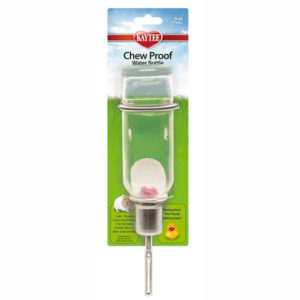 Chinchillas need fresh water available to them at all times. The best way to provide water to your pet is with a water bottle. Water crocks and bowls are easy to spill, which can make a mess in your chinchilla’s cage. They also allow for water to be contaminated with dirt, waste, or hair.
Chinchillas need fresh water available to them at all times. The best way to provide water to your pet is with a water bottle. Water crocks and bowls are easy to spill, which can make a mess in your chinchilla’s cage. They also allow for water to be contaminated with dirt, waste, or hair.
A non-drip water bottle should be installed on the outside of your chinchilla’s cage to provide unlimited access to water.
Read more about chinchilla water bottles and see our product suggestions.
Food Dishes
Your chinchilla cage should have at least one food dish to serve pellets. You can have multiple food dishes if you have multiple chinchillas. You want to make sure the dish is made of a safe material to prevent your pet from chewing it (no plastic). The dish should also be heavy enough to avoid being tipped over or it should mount to the side of the cage.
Read more about chinchilla food dishes and see our product suggestions.
Hay Racks
Chinchillas should be provided with unlimited access to fresh hay. The best way to do this in their cage is by using a hay rack or other type of feeder.
These hay holders help to reduce mess and keep hay off shelves and the floor of their cage. Chinchillas often will pee on piles of hay as if they’re a litter box, so hanging a hay rack from the side of the cage helps eliminate that issue.
Read more about chinchilla hay racks and see our product suggestions.
Litter Boxes
 If you want to reduce the amount of cleaning you need to do in your chinchilla’s cage and save money by using less bedding or litter you may want to potty train your chinchilla. Once they’re potty trained, instead of covering the entire bottom of the cage in bedding, you can just use a litter box or pan in the corner of the cage.
If you want to reduce the amount of cleaning you need to do in your chinchilla’s cage and save money by using less bedding or litter you may want to potty train your chinchilla. Once they’re potty trained, instead of covering the entire bottom of the cage in bedding, you can just use a litter box or pan in the corner of the cage.
Most litter boxes sold in pet stores for small animals and exotic pets are plastic, which you should not buy for your chinchilla. Instead, you should look for metal or ceramic litter box options. You may have to to get a little creative with which department you look for chinchilla litter boxes in. Check out our suggestions and learn more about chinchilla bedding and litter boxes.
Chinchilla “Furniture”
Chinchilla furniture is what we’re categorizing shelves, houses, and other fixtures that may be used in a chinchilla cage or in a playpen for exercise time. These are essential for every chinchilla cage. Chinchillas love to hop, climb, hide, and chew, and they need this furniture to help meet all of their needs.
Cage Shelves and Ledges
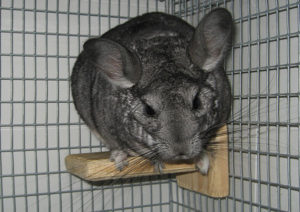 Shelves and ledges should be considered an integral part of the cage structure. Chinchillas need multiple levels to explore and hop around inside their cage. Shelves should be made of chinchilla safe material, usually wood, and never made of plastic.
Shelves and ledges should be considered an integral part of the cage structure. Chinchillas need multiple levels to explore and hop around inside their cage. Shelves should be made of chinchilla safe material, usually wood, and never made of plastic.
What sizes and shapes of shelves you buy are up to you. There’s an unlimited number of ways to set up your chinchilla’s home that are only dependent on the size of the cage, your budget, and your imagination.
Check out our suggestions and learn more about chinchilla ledges, shelves, and perches.
Houses
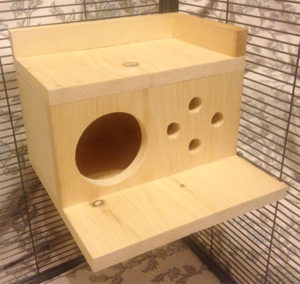 A chinchilla house or hideout is a very important part of your pet’s home. They need a safe space they can go to if they feel stressed. Plus it often doubles as their sleeping space during the day when your house is active but they are tired. You should have one chinchilla house per chinchilla in your cage setup.
A chinchilla house or hideout is a very important part of your pet’s home. They need a safe space they can go to if they feel stressed. Plus it often doubles as their sleeping space during the day when your house is active but they are tired. You should have one chinchilla house per chinchilla in your cage setup.
Since it’s inside their cage and they will have constant contact with it, the hideout should be made of chinchilla safe materials and never plastic. You can get a house that sits on the floor of the cage or one that mounts to the cage bars or ceilings.
Check out our suggestions and learn more about chinchilla houses, hideouts, and nest boxes.
Shelf Liners
If your chinchilla cage comes with plastic or wire shelves, you should either remove them or cover them for your pet’s safety. The easiest way is to cover them with fleece liners. Fleece is a safe fabric that most chinchillas won’t chew or eat. It’s also very absorbent and can be used as a reusable alternative to disposable litter.
Liners are available pre-made for most common chinchilla cages or you can make them yourself. Check out our favorite fleece chinchilla cage liners.
Hammocks and Beds
In addition to all the wood and metal in their cage, chinchillas also need soft surfaces they can rest their feet on and cuddle up to sleep on. The easiest way to provide this is with a fleece hammock or bed. There are many options available that are safe for chinchillas, especially now that chinchilla owners are making their own cage accessories design specifically for chins. If you’re shopping at the pet store, make sure any hammock or bed you consider is made of fleece and not other fabrics, vinyl, or plastic.
Check out our recommendations and learn more about chinchilla hammocks and beds.
Chinchilla Toys and Fun
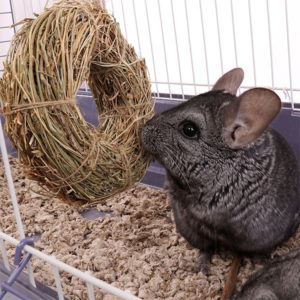 Toys are not just some accessories you can buy for your chin, they’re actually extremely important for the health and well-being of your pet. Toys help relieve boredom which is good for your chinchilla’s mental health. They also help give them a safe outlet for their constant need to chew. Providing a variety of toys made of different materials helps your chinchilla wear their teeth down, keeping their mouth healthy and happy.
Toys are not just some accessories you can buy for your chin, they’re actually extremely important for the health and well-being of your pet. Toys help relieve boredom which is good for your chinchilla’s mental health. They also help give them a safe outlet for their constant need to chew. Providing a variety of toys made of different materials helps your chinchilla wear their teeth down, keeping their mouth healthy and happy.
Toys should be provided in their play area to keep them from chewing on things they shouldn’t eat during playtime (like furniture, books, or wires). Your chinchilla should also have a variety of toys available in their cage to keep them entertained during the rest of the day. Hanging toys and toss toys work very well to keep your chinchilla amused and happy. Read more about chinchilla toys and chews to find out what options are available and how to make your own toys. On a budget? Check out DIY Toilet Paper Roll Toys that you can make from items around the house.
Ladders, Bridges, and Swings
If there’s enough space in your chinchilla’s cage, you can get more creative than just regular shelves. There are a variety of chinchilla safe ladders, bridges, and swings to furnish your cage with. These accessories can stimulate and engage your pet as they climb, jump, and play.
Tunnels
Tunnels are a fun option for play time or as a cage accessory. Chinchillas love to run through and under tiny spaces, and sometimes enjoy curling up inside of them to nap.
Some tunnels are best for outside the cage play time (see some recommendations here), but there are also tunnels that you can mount in your chinchilla’s cage. PVC pipes are a very popular option, though they should be covered with fleece for your chin’s health and safety. Wooden tunnels also work well.
Exercise Wheels
 A chinchilla wheel is a fun addition to make to your pet’s cage. There are plenty of chinchilla safe wheels available to give your pet a fun outlet for their extra energy. They also help your chinchilla stay trim and healthy. These are a great accessory for chins that are a little chubby and need to lose weight.
A chinchilla wheel is a fun addition to make to your pet’s cage. There are plenty of chinchilla safe wheels available to give your pet a fun outlet for their extra energy. They also help your chinchilla stay trim and healthy. These are a great accessory for chins that are a little chubby and need to lose weight.
There are a lot of wheels in pet stores marketed toward chinchillas that actually aren’t good for them. They may be too small or made of plastic that your chinchilla will chew up. If you want to add an exercise wheel to your cage, check out our recommendations for chinchilla wheels.
Wood Toys
Some of the most fun you’ll have as a chinchilla owner is buying toys for your exotic pet. You can buy pre-made toys in pet stores or online or buy wood and toy parts to make your own. The most important part of this process is to make sure that any toys or toy parts you buy are made of chinchilla safe wood and materials. Read more about wood toys and toy parts.
Chinchilla Cage Setup Ideas
Now that you have all the chinchilla cage accessories you need, you may be wondering exactly how to set up a chinchilla cage. While you should keep in mind a few rules for safety, you don’t have to stress out about getting the layout “just right.” You can reorganize, change, and add accessories at any time for what makes sense for your pet chinchilla.
Safety Tips for Setting Up Your Chinchilla Cage
The first thing you need to keep in mind when setting up your cage is doing some preventative arranging to make sure your chinchilla cannot be injured in the cage.
Prevent Dangerous Falls
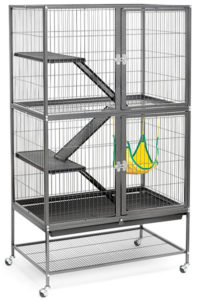 The first thing to look at is the height of the cage and whether it’s possible for your chinchilla to fall and hurt themselves. If you’re using a shorter cage to house your chin there may not be much to worry about (except for making sure they get a lot of exercise time outside of their cage). If the cage is taller, giving a lot of space to climb and jump, you want to make sure shelves are placed in a way to prevent long-distance falls. Some chinchillas are a little klutzy or may misjudge a jump and could fall. Your cage should be arranged so the chinchilla wouldn’t fall more than 24″.
The first thing to look at is the height of the cage and whether it’s possible for your chinchilla to fall and hurt themselves. If you’re using a shorter cage to house your chin there may not be much to worry about (except for making sure they get a lot of exercise time outside of their cage). If the cage is taller, giving a lot of space to climb and jump, you want to make sure shelves are placed in a way to prevent long-distance falls. Some chinchillas are a little klutzy or may misjudge a jump and could fall. Your cage should be arranged so the chinchilla wouldn’t fall more than 24″.
Many of the taller cages marketed for ferrets, like the Prevue Feisty Ferret Cage (pictured right) comes with a shelf that spans the entirety of the cage at mid-height. This greatly reduces the chance of a dangerous fall when your chin is playing high up in their cage. Often these are wire shelves, which aren’t safe for chinchillas who might get tiny feet caught in them, so you can make or buy fleece shelf covers to make them safer.
If your cage does not have a shelf like that, you can use some strategic design to remove any fall heights greater than 24″. Use numerous shelves at different levels to make sure there’s always a surface to land on. Fleece hammocks are another great option because they offer a soft landing. You can buy or make a hammock that spans the width or length of your cage.
Remove Plastic
If your cage comes with plastic shelves, ramps, or other accessories, you should seriously consider removing them or covering them to prevent your chinchilla from chewing on them. If you provide enough safe wood alternatives for them to chew on like toys, your chinchilla may not try to chew on the plastic. But, most will try. The chewing isn’t the issue, but if your chin ingests any of the plastic it can cause intestinal blockage and be fatal. Instead, opt for replacing them with wood shelves or cover them with fleece to make them safer.
Secure Heavy Accessories in the Cage
Make sure all heavy items in the cage can be secured safely to the cage walls or ceiling. Shelves, hidey houses, heavy food crocks, etc. should all be secured to the side of the cage. If an item cannot be secured (like a free standing house), it should be placed on the cage floor or a shelf that spans the width of the cage. This is to avoid the chinchilla pushing or kicking the heavy item off the ledge where it could injure another chinchilla below or break something within the cage.
Chinchilla Cage Layout Ideas
Once you take safety into consideration, the layout of your cage is up to your imagination and your chinchilla’s preference. Still, it’s always fun to see how other chinchilla owners set up their cages. Here are some examples from around the web that may help inspire you. We have added comments for any recommended changes to the layout.
This is a great example of a layout for a shorter chinchilla cage. It looks like a tall one, but both of these chins actually have seperate living spaces. This owner made good use of wood shelves and a mountable hidey house. Each chinchilla also has an exercise wheel on the lowest level, which is the safest place to mount a wheel.
While we’re worried these chins won’t get enough ventilation in this cage with solid sides and might overheat, the layout is great. This is a wonderful example of how to use shelves to break up a taller cage to prevent dangerous falls.
This cage uses a combination of wood shelves and fleece tubes to create a variety of surfaces for chinchillas to run and play through. I would maybe add some more shelf coverage or a large hammock at mid height to prevent any long distance falls.
This is a perfect example of utilizing a cage-width shelf at mid height to prevent dangerous falls. The owner covered the wire shelf with fleece and added wooden shelves and fleece throughout to give lots of room to hop and explore.
